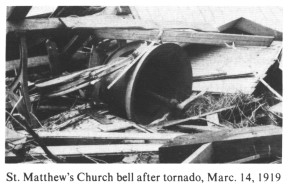 |
| St. Matthew's Church bell after tornado, March. 14, 1919 |
On Feb. 1, 1920, Rev. A. Grosse became the 7th shepherd. Zion Lutheran organized in town in 1926. Pastor Grosse was requested to serve this congregation. In 1936, due to the depression the school was closed. Rev. Grosse served both churches until his death in 1942. Rev. August Wolter was installed in 1942. On Oct.31, 1943, St. Matthew and Zion were consolidated into one congregation. In 1944, the rural church was moved into town, remodeled and dedicated Dec.10, 1944. On June 24, 1949 Rev. Wolter died.
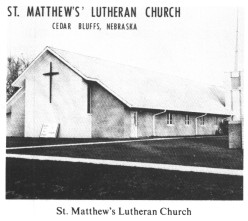 |
| St. Matthew's Lutheran Church |
Rev. Luther Doctor was installed Sept. 4, 1949. A new parsonage was dedicated Dec. 11, 1949. Jan. 1, 1953 Rev. Doctor gave his farewell sermon and on March 29,1953 Rev. Fred Falkenroth came. Pastor Falkenroth left in March 1957 and Rev. Arlin Holtz served from Sept.1957 to June 1960. Rev. Burnell Beyers was installed Dec. 4, 1960 and served till March 1975. On Dec.12, 1965, Dedication Service was held for the present church facilities. Rev. Allen Aschbacher was installed July 20, 1975 and served until Dec.1978. Our 100th Anniversary was celebrated on August 20, 1978. Rev. Fred Hertwig was installed June 22, 1980 and is our current pastor.
ELIZABETH PORTER
Excerpts from a diary kept by a teacher (Elizabeth Porter) describing her new career of teaching at Dist. 26, Cedar Precinct:
Sept. 2, 1916. Today marks the beginning, the actual work of my career, the career which to me means so much. It is for me to make or mar (but there is to be no thought of the latter.) I have a grand place to stay. A lovely room, everything as handy as a pocket in a shirt.
Sept. 4. School opened with no trouble. Mrs. Bessie brought 4 pupils as her contribution. It is a good little school but needs a stiff hand. Got a ride home with Mr. Sam Blair in his fine big car. He tole me "not to take any sass off his children." Monday was a dreadfully hard day.
Wed., Sept. 6. That school is a holy terror. But we will hope for the best.
Thurs., Sept. 7. 21 years old today. Mr. Milton sent word if I couldn't make the kids mind any other way he'd get me a good raw-hide whip. Henry had a chance to sit in the hall by himself for an hour until he could sober up.
Fri. nite. Hunted wool blankets. Folks came for me in Tin Lizzie. I was sure glad to see them.
Monday. I found a feather bed on my sleeper when 1 got back. Heaven-ly Father! I'm glad. After school tonight Henry hit Rhueben on the forehead with a hunk of coal. I just took coal, boy and myself up to make a friendly (?) call on Mrs. Paulson. We had quite a talk and some clear understandings.
Tues. Today went better. Hilda swept for me tonight. At present, I'm trying to warm some water by cooling my feet.
Wed. Clarence had a first class tantrum today. (Likewise, brother Percy).
Thurs. Lester told me today I was making a pretty good stab at school teaching. I told him I'd licked two already and he'd be next.
Fri. Oscar got a good tanning today. Things are straightened out. I think that will settle it all. Caught another mouse in the schoolhouse.
Sat. My brother came for me in the Tin Lizzie. He coasted down Paulson's hill, turned in and started the engine, and we went back without having to crank it.
I heard from some one, who over heard Sam Blair telling in town, what a fine teacher they had out here. He said, "I tell you she makes the kids mind. That's what I like. I tell you, I think she's just fine."
I guess my career is started!
HISTORY OF DISTRICT 65
The history of our school district, Dist. 65, is a long and interesting one. It started with a letter to Samuel Schofield, requesting that he let eligible voters know of a meeting on Saturday, February 24, 1872. It would be held at Mr. Schofield's home. The people who met were: George Orme, Calvin Hubbard, Jon Douney, George Hamen, Phillip Getslar, Joseph Zapp and Fredrick Hancock. The proposed school district was to be composed ofsections 24, 25, 26, 27, 34, 35 and 36, in Township 16, Range 7, East.
The schoolhouse that was built was 18 ft. wide by 26 ft. long by 10 high on the inside. It was built on an acre of land donated by Samuel Schofield to be used for school purposes.
It is thought that this schoolhouse burned in 1882 after travelers left from camping there. It is said that four or five wagons at a time would be parked on the school grounds. The next schoolhouse was built the same year.
There is a rather humorous story connected with the Blizzard of 1888. That day all the children came to school to find no teacher. The teacher boarded with the Hickles, who lived about one-eighth of a mile from school. This family had five children, a hired man, a hired girl and they also boarded teachers. This doesn't seem unusual until you add the fact they all lived in a two room establishment which is now used as a washhouse! A brother of the head of the family lived on the same place in just as small a house, with twelve children. Getting back to the story, the teacher never came to school that day. The Hickle boy never said anything about the teacher not coming. The children stayed, ate lunch and did everything but walk the ceiling. It had started to snow, so they decided to walk home. Thus they missed the blizzard.
The next part in the history is the building of the third schoolhouse. Frank Dolezal and Joe Vybiral were appointed to the building committee. The building contract was awarded to Walter Van Gerpen of Fremont for $3355. The final cost of the present building was $3626.45. It was moved by Frank Dolezal and seconded by Anton Kralik to sell the old schoolhouse after the new one was completed. The old one was sold for $78 to move to Colon for playing cards. It was called the Rinky-Dinky.
In 1972, the district was consolidated with District 60 and the school was closed.
The building has been remodeled into a beautiful private home for the Tom Gray family.
DISTRICT #107
The first school building was the old grange hall moved in from the country, with Mrs. David Yung the first teacher. Today, the school consists of an elementary building with a multipurpose room, library, and hot lunch kitchen, built in 1970. Today there are 84 children in grades k-6.
The high school sits beside the elementary building, the same building that once housed the entire school (built in 1914, it was the 3rd high school in the county) now provides only part of the class rooms necessary for the high school. in 1976, the new gym was completed; this building also houses the large shop room for the industrial arts, art room, home economics, science dept., and band room.
The school has a teaching staff of 24, plus a secretarial staff, maintenance staff, and cooks for the hot lunch program. Mr. Charles Runty is the Superintendent and Mr. David Kroger is the High School Principal.
The school has a complete music dept. plus athletic department with sports for both boys and girls -- ranging from football, basketball, volleyball, track and cross-country running events. The high school draws students from as far as WoodCliff and the Colon area.
ELECTRICITY COMES TO
CEDAR
In 1911, an agreement to purchase electricity was made with Fremont Gas & Electric Co. The Village would build a transmission line from Cedar to the south banks of the Platte, where it would connect with a line from Fremont. In May, 1912, the electric system was completed with 88 patrons. A farm line was stretched in 1919, both east and west for five miles
In 1928, Nebraska Power Co. purchased the system from the village. Omaha Electric Committee purchased it in 1944. Omaha Public Power Dist. contracted to buy the system in 1946. Today, they have one of the new buildings in Cedar, employing five employees.
EASTERN STAR
Evergreen Chapter No. 138, Order of the Eastern Star in Cedar Bluffs was granted their Charter April 28,1900, from Grand Chapter of Nebraska. There were 26 members initiated to the order by the Worthy Grand Matron and the sister chapter in Fremont who conducted the initiatory work. Chapter has met regularly on the second Monday of the month at the Masonic Lodge. The Masonic Lodge was located on the corner where the Legion Building now stands.
Mary D. Peck was the first Worthy Matron and Jesse Gidley the First Worthy Patron in 1900. George and Loretta Iverson are the 1983 installed Worthy Matron and Patron.
There are 52 members as of January, 1983. Walter and Louise Fleming of Morse Bluff were initiated Nov. 1913 and Roma Schere of Cedar Bluffs in May 1923 and are the longest active members. All have held many offices and have been supportive in all activities. Patricia Janovec, Secretary
page 52
AMERICAN LEGION
An American Legion unit was started in 1919 but did not remain active. In 1922 it was reorganized and has since been very active. It is known as the Ernest Stuehrk Post in honor ofthe first World War I casualty. Seventy-eight men and two women served in WWI. Chris F. Dockweiler is the only living veteran of WW I.
During WWII, the Cedar Bluffs men once again answered the call. Wayne Keller was standing on the beach in Honolulu looking out across the bay when the Japs swooped in with their bombs. Ed Stejskal was on the first wave to hit Omaha beach. John Vaca was on the second wave. Under Gen. Patton's command he fought with the French across France, Germany ending up in Austria A. E. Clinkenbeard fought under Gen. MacArthur in the South Pacific invasion. Bill Fleming flew bombing missions over Germany from England Ray E. Grosse served in the 1st Aggressive Invasion in the So. Pacific with the Submarine Service.
Elmer Hoffman, Loyd Clapham Albert Sukstorf and Robert Wilcox gave their lives in WWI II. Lawrence Wolf was a POW in Germany.
Ed Farr served with the Sea Bees in the So. Pacific In 1980-81 he was elected Nebraska Commander of the American Legion.
Cedar boys answered the call to go to Korea and once more to Viet Nam, but we were fortunate to lose none of our boys in these two conflicts.
Each year the Legion selects a boy from the community to sponsor at Boys' State held in Lincoln.
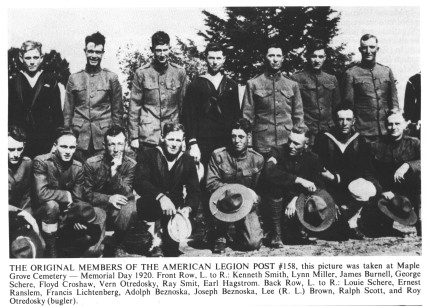 |
| THE ORIGINAL MEMBERS OF THE AMERICAN LEGION POST #158, this picture was taken at Maple Grove Cemetery -- Memorial Day 1920. Front Row, L. to R.: Kenneth Smith, Lynn Miller, James Burnell, George Schere, Floyd Croshaw, Vern Otredosky, Ray Smit, Earl Hagstrom. Back Row, L. to R.: Louie Schere, Ernest Ranslem, Francis Lichtenberg, Adolph Beznoska, Joseph Beznoska, Lee (R. L.) Brown, Ralph Scott, and Roy Otredosky (bugler). |
AMERICAN LEGION AUXILIARY
The unit was organized under the direction of District Seven president, Mrs. Rose Lynnequist. The first meeting was held on April 2, 1941. The Unit Charter was received April 19, 1941. There were 21 unit Charter Members. Only two of this number, Eva Schere and Anna Brown, still remain charter members.
The veterans make poppies which are sold each year by the Auxiliary Community service is one priority. Gift shop and hospital assignments are filled.
Erma Ranslem and Eva Schere were the first delegates sent to State Convention. Eva was also the first delegate to the National Convention.
Each year a girl from the community is chosen and sponsored at Girls' State.
Total membership to date is 96. submitted by Eva Schere
THE OLD HOMESTEAD
The old farmouse
where I was born
is gone --
Bulldozed,
Buried.
The walnut grove
planted by Grandma
long ago,
has been uprooted -- sold
to the highest bidder.
Barns were burned down;
the old windmill collapsed;
the rusty pump
run dry --
lost to time.
Despite all this,
I find myself
driving past the place
where it all once stood.
And feeling sad,
as when I visit
the gravesite
of a loved one.
Tears make it hard
for me to see
as I drive on.
by Edna Mae (Hoevert) Klumpp
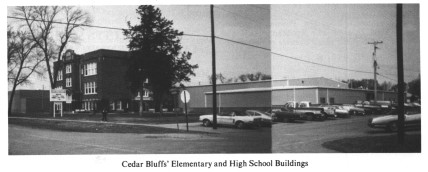 |
| Cedar Bluffs Elementary and High School Buildings. |
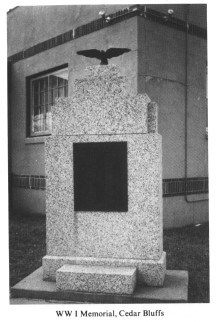
WW I Memorial, Cedar Bluffs |
CEDAR BLUFFS FIRE
DEPARTMENT
Fire Department records date back to 1900; there was a department before that but no records were kept. In 1900, Ed Peck held the position of Fire Chief, and there were 26 members. They sponsored dances held at the Olsen Opera House with the Malloy Orchestra furnishing the music. The by-laws and constitution were drawn up in 1902; with very few changes, these still stand today as a guide to the order and control of the Department. Roof ladders, hose carts and hand-operated pumpers were used. Instead of blowing a whistle, a fire bell was rung to call the firemen
In 1906, the first uniforms were purchased. They were worn for parades and drills. The Department joined the Nebraska State Volunteer Firemen's Association in 1908. In 1924, the city levied .4 of a mill tax for the purchase of fire-fighting equipment, and in 1926, with the help of a fund-raising drive, the Cedar Bluffs Fire Department bought its first truck.
The meeting room was obtained by purchasing the old Firemen's Hall. This meeting room was purchased from the Library Reading Association in 1928 with department funds.
In 1939, there were woodburning stoves which caused chimney fires. Firemen combatted these fires with chemical bags which consisted mostly of baking soda and salt. Life-saving equipment, a resuscitator and gas masks were purchased by the Department in 1944. This equipment is kept up to date and is ready for use at all times. |
page 53
|

